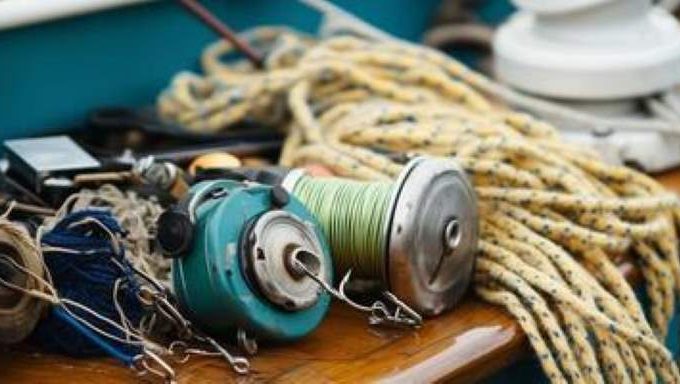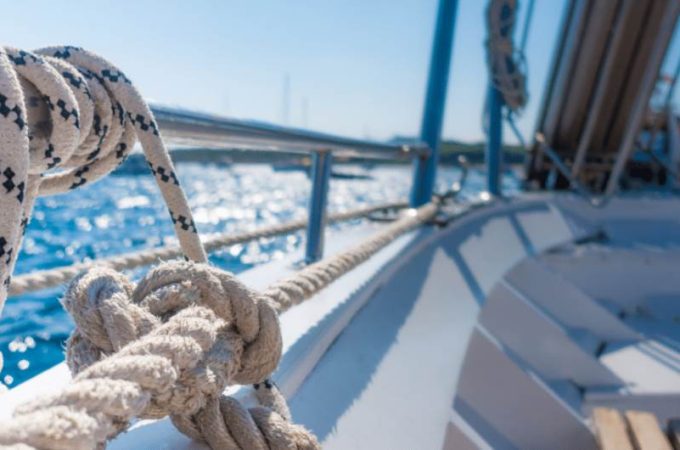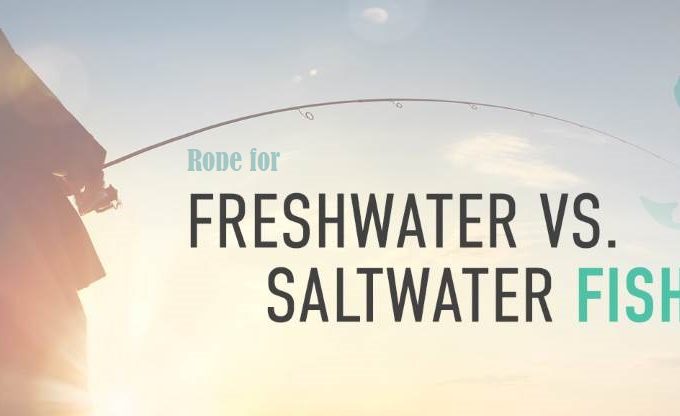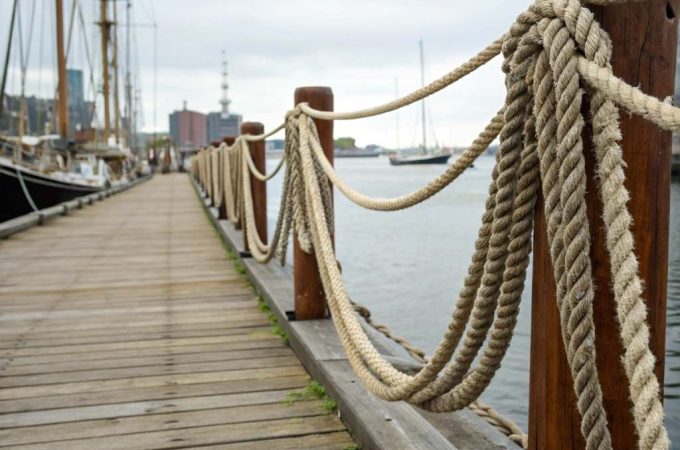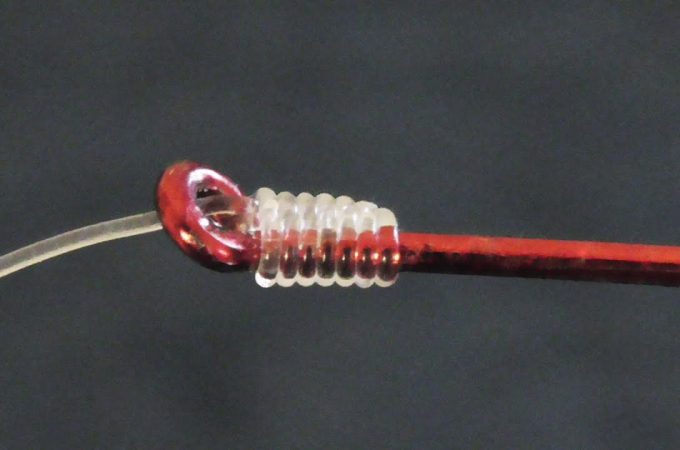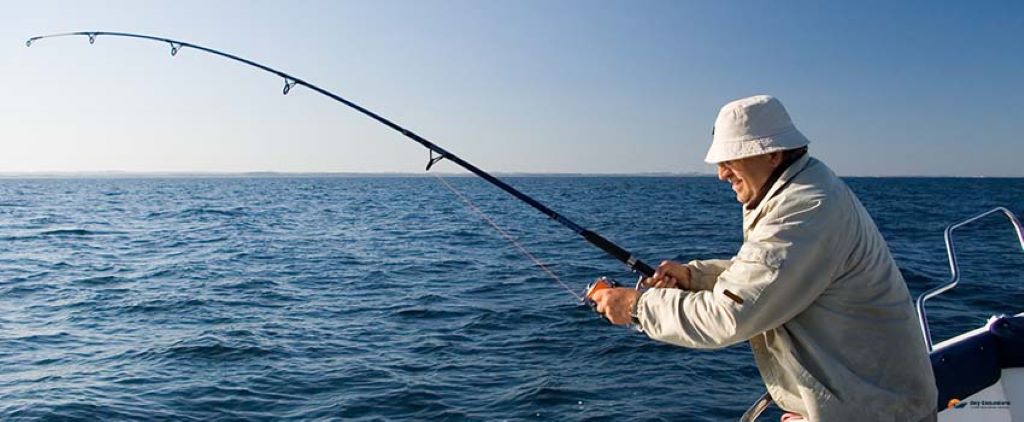
The Ultimate Guide to Choosing the Right Fishing Rope for Saltwater Adventures: Unravel the Best!
Selecting the ideal fishing rope for saltwater requires recognizing materials that resist corrosion and boast high tensile strength. Durability and functionality are key factors for a successful saltwater fishing experience.
Contents at a Glance
ToggleEmbarking on a saltwater fishing adventure demands the right gear, and the selection of the perfect fishing rope is paramount. Saltwater environments challenge fishing equipment with corrosive elements and rough conditions, making the choice of rope not just a matter of convenience, but of safety and efficiency as well.
A high-quality fishing rope can mean the difference between a triumphant catch and a lost opportunity. With the myriad of options on the market, anglers must consider material, diameter, strength, and resistance to the elements. A good fishing rope integrates into the angler’s toolkit, ensuring that every cast and haul is completed with confidence. Making an informed decision will equip any fishing enthusiast with the necessary tool for tackling the sea’s unpredictability, preserving the integrity of their gear in the long run.
Saltwater Challenges: The Need For Durable Fishing Rope
Casting a line into the vast blue may seem endless and exciting. There is a silent battle at play. The rope you rely on to haul your catch is fighting its own duel with saltwater. Every fishing enthusiast knows the need for a strong, resilient rope. This unseen hero bears the brunt of the harshest marine conditions. So, choosing the right kind of rope is vital to ensure a successful and enjoyable saltwater adventure.
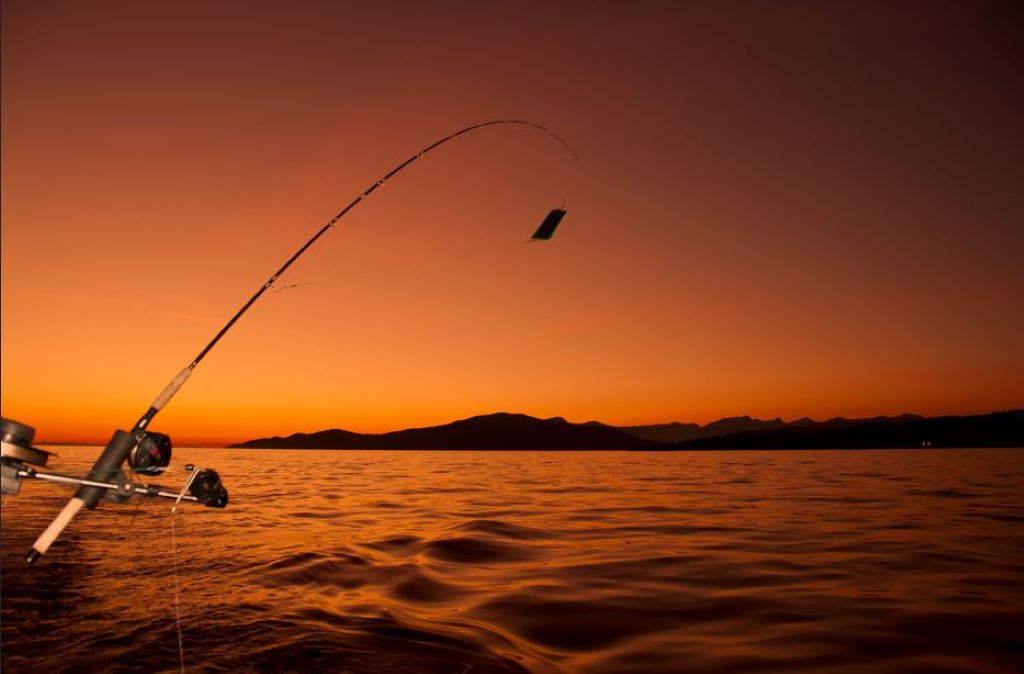
Corrosive Effects Of Saltwater
Saltwater presents unique challenges. The constant exposure can weaken ordinary materials. This is why durability in fishing rope is not just a preference, but a necessity. Salt has a sneaky way of accelerating corrosion, making robust rope choices a top priority. Check out how your rope can suffer under this salty siege:
- Fiber Damage: Salt crystals penetrate the fibers, causing fraying and breakage.
- Color Fading: Vibrant ropes can lose their color, turning dull.
- Reduced Flexibility: Ropes become stiff, difficult to handle and knot.
Tough Marine Environment Versus Material Wear
The open sea is not a playground for the weak. Any material we use must confront a gauntlet of obstacles. From sharp-edged shells to abrasive sands, the list is daunting. But fear not, as the right type of rope can stand tall against these adversaries. Below, you’ll find a brief insight into what your rope must endure:
| Environmental Element | Impact on Rope |
|---|---|
| UV Radiation | Weakens and degrades fibers over time |
| Sharp Objects | Causes cuts and abrasions |
| Variable Temperatures | Influences rope stiffness and strength |
To sail past these hurdles, the choice of material and construction of your fishing rope counts. Look for ropes with built-in resistance to UV light and abrasion. Also, the right material can maintain its integrity in changing temperatures. Make a smart choice and your rope will likely return the favor with reliable performance.
Rope Fibers Face-off: Synthetic Vs. Natural
Fishers often ponder between synthetic and natural ropes for their saltwater adventures. Each type brings unique benefits and drawbacks. Learn what suits your maritime needs best through this detailed comparison: synthetic versus natural fibers.
Polypropylene And Polyester Pros
- Synthetic ropes like polypropylene are lightweight. They float in water, making them easy to retrieve.
- Polyester is known for its incredible strength. It holds up well under the harsh saltwater conditions.
- Both these synthetics resist UV light damage. They last longer even under the sun.
- Maintenance is simple—they don’t absorb water, reducing the chances of rot, mildew, and foul odors.
These materials are perfect for those who need durable, easy-to-handle, and low-maintenance ropes.
Traditional Hemp And Manila Comparison
- Manila ropes, made from natural hemp fibers, have a classic feel. They are biodegradable and eco-friendly.
- Hemp ropes offer a natural grip. This can be crucial during intricate knotting or in slippery conditions.
- They are more prone to rot due to water absorption. Proper drying and storage are essential.
- Manila ropes can shrink when wet, possibly altering their length and performance.
| Material | Pros | Cons |
|---|---|---|
| Polypropylene | Lightweight, floats, UV resistant | Less grip when wet |
| Polyester | Strong, UV resistant, low maintenance | Heavier, more expensive |
| Hemp/Manila | Eco-friendly, natural grip | Can rot, may shrink when wet |
Consider these factors when choosing your next fishing rope for saltwater adventures. Your choice will impact the ease and success of your experience.
Strength And Knotting: Core Features
Choosing the right fishing rope can make or break your saltwater excursion. Rope strength ensures safety and durability, while proper knotting affects functionality. Below, we dive into two essential properties: Breaking Strength and Load Ratings, and Knot Retention and Easy Handling.
Breaking Strength And Load Ratings
The breaking strength of a rope indicates the maximum load it can handle before it fails. When selecting a fishing rope, knowing the weight of your target catch is crucial. Choose a rope with a higher breaking strength than the anticipated load. This will provide a safety margin while battling strong currents and large fish.
Load ratings are often listed in pounds or kilograms. Check product specifications for these values. To help you understand better, consider this table showing common rope types and their average breaking strengths:
| Rope Type | Average Breaking Strength |
|---|---|
| Nylon | 9,000 lbs |
| Polyethylene | 5,400 lbs |
| Polypropylene | 7,500 lbs |
Knot Retention And Easy Handling
A fishing rope must hold knots well while being easy to tie and untie. Good knot retention means the rope maintains its hold under dynamic conditions without slipping. This is vital for securing boats, gear, and catches. Soft ropes with a fibrous texture tend to hold knots tightly.
Handling is just as important. You need a rope that’s easy to grip, even when wet. A rope that doesn’t kink prevents unnecessary delays. Look for ropes with a balanced braided construction, as they typically offer better handling. Consider these points for knot retention and handling:
- Texture: Choose ropes with a rougher surface for better grip.
- Flexibility: Flexible ropes make stronger knots.
- Memory: Ropes with less memory stay knot-free when uncoiled.
Diameter And Length: Sizing Up Your Rope
Finding the right fishing rope for saltwater pursuits is a game-changer. The diameter and length of your rope ensure safety and efficiency. The choice depends on the type of angling and personal needs. Let’s break down how to select the best size for your maritime adventures.
Determining Optimal Thickness
The thickness of your rope, or diameter, is crucial. It affects durability, handling, and winch compatibility. A thick rope withstands heavy loads, whereas a thin line is easier to tie. Different fishing styles require unique diameters:
- Heavy-duty fishing: Choose a diameter of at least 1/2 inch (12.5 mm).
- General-purpose: 3/8 inch (9.5 mm) is flexible and common.
- Light use: A diameter around 1/4 inch (6 mm) will suffice.
A simple visual comparison or a use of calipers can help confirm the diameter. Always compare rope thickness with your vessel’s requirements.
How Length Influences Utility
The rope length extends your reach and determines how far you can anchor or tow. A long rope is versatile, but it also needs more storage space. Shorter ropes are easier to manage but may limit operations. Consider these factors:
| Situation | Rope Length |
|---|---|
| Deep-sea fishing | At least 600 feet (183 meters) |
| Reef fishing | 300 to 500 feet (91-152 meters) |
| Inshore fishing | 100 to 200 feet (30-61 meters) |
Measure your current rope or use a rope length calculator for accuracy. Always have an extra length for emergencies. Matching the right diameter and length of your rope with your fishing needs guarantees a great trip every time.
Uv Resistance And Rope Lifespan
Fishing in saltwater often means your gear faces harsh sun rays. The right rope can stand up to this challenge. Let’s explore how UV resistance is key to longer rope life.
The Impact Of Sunlight Exposure
Direct sunlight can weaken your rope, causing it to fray and fade. Salty air couples with UV rays, degrading rope fibers over time. Choosing a rope with built-in UV protection ensures strength and durability during countless sea-bound trips.
Extending Your Rope’s Life
To maximize your fishing rope’s lifespan, consider these tips:
- Rinse with fresh water after each use to remove salt.
- Store in a cool, shaded area when not in use.
- Perform regular inspections for any signs of wear or damage.
- Choose ropes with color fastness to maintain appearance.
Invest in a rope treated for UV resistance. It pays off as the rope lasts longer and saves money on replacements.
Related: FISHING ROPE AND SAFETY: SECURE YOUR CATCH SMARTLY!
Color Coding: Strategy For Rope Management
Managing ropes on a saltwater fishing trip demands efficiency. Diverse activities call for different ropes. Color coding simplifies rope management. It ensures the right rope is always at hand. Let’s dive into how color can keep you organized and safe in the deep blue.
Visibility Underwater
Fishing ropes must stand out against the sea’s backdrop. Colors like neon yellow or fluorescent orange can be seen easily underwater. Bright colors are vital during deep-sea dives or when ropes trail into the depths. They help avoid entanglement with marine life and gear. Choosing a rope with high visibility can mean the difference between a successful outing and a maritime mishap.
Organizational Tactics On Deck
On deck, the right rope quickly is crucial. Color coding helps here too. Assign colors based on rope function. For example:
- Anchor lines – blue
- Trailing lines – red
- Utility purposes – green
| Rope Purpose | Color |
|---|---|
| Docking | Brown |
| Towing | White |
| Safety | Orange |
This system prevents confusion and enhances safety. Crew members can grab the right rope without hesitation. Having a well-implemented color-coding system can save time, prevent accidents, and keep your deck orderly.
Maintenance And Care: Ensuring Long-term Performance
Fishing ropes handle heavy loads, resist salty waters, and endure extreme weather. To ensure they perform well on your saltwater adventures, proper maintenance and care are key. With the right steps, these ropes can last longer and save money. This guide walks you through cleaning techniques and preventative measures to combat rope degradation.
Cleaning Techniques
Salt and grime can shorten a rope’s life. Regular cleaning maintains its strength. Follow these steps:
- Rinse the rope with fresh water after use.
- Use a mild detergent and a soft brush for a gentle scrub.
- Soak in a bucket if heavily soiled, then rinse thoroughly.
- Allow to air dry completely before storing. Avoid direct sunlight to prevent UV damage.
Preventative Measures For Rope Degradation
Keep ropes away from harsh environments when not in use. Use these tips:
- Store in a cool, dry place to prevent mildew and dry rot.
- Avoid contact with sharp objects or surfaces that can cause tears.
- Keep away from chemicals and oils that can break down fibers.
- Inspect regularly for signs of wear or damage.
- Apply protective coatings if recommended by the manufacturer.
Case Studies: Veteran Anglers’ Rope Selection Wisdom
Fishing in saltwater demands not only skill but also the right equipment. One often overlooked component is the fishing rope. This guide dives into the insights gathered from veteran anglers and their real-world experiences. Learning from their triumphs and errors can make all the difference in rope selection.
Real-life Success Stories
Expert fishers swear by choosing the correct rope. Through trial and error, they’ve uncovered what works best.
- Durability triumphs: Nylon ropes thrive in saltwater due to their resilience against abrasion and decay.
- Size matters: Thicker ropes ensure better grip and strength, a prime choice for battling larger catches.
- Float or sink: Polypropylene, a rope that floats, aids surface-level fishing, while sinking ropes suit deep-water activities.
Mistakes To Avoid From Seasoned Pros
Seasoned anglers have witnessed their fair share of mishaps. Stroke down notes from their errors to avoid the same fate.
| Mistake | Lesson Learned |
|---|---|
| Ignoring Water Absorption | Choose ropes that resist water to prevent weakening and heavy lifting. |
| Favoring Price Over Quality | Invest in quality ropes to avoid frequent replacements and potential failures at sea. |
| Neglecting UV Resistance | Select UV-resistant ropes to prolong lifespan under harsh sunlight. |
Cutting-edge Advances In Rope Technology
Cutting-edge advances in rope technology transform anglers’ experiences. Saltwater demands robust, durable, and adaptable equipment. Recent innovations in fishing rope design offer solutions. These breakthroughs balance strength, longevity, and functionality. This guide dissects these advances. Anglers find the best rope for their maritime journeys.
Innovations In Synthetic Fibers
The core of today’s superior ropes lies in synthetic fibers. High-tech materials like Dyneema and Spectra lead the charge. These fibers boast impressive traits:
- Incredible strength-to-weight ratio
- Resistance to abrasion
- Ultraviolet (UV) damage resilience
- Minimal water absorption
Such features make synthetic ropes ideal for saltwater fishing. They endure the harsh oceanic environment.
Smart Ropes: Next-generation Tools
Smart ropes redefine fishing adventures. These innovative ropes have built-in sensors. They provide crucial data:
| Data Type | Benefit |
|---|---|
| Load tension | Ensures safe weight distribution |
| Movement | Detects shifts, prevents accidents |
| Wear and tear | Predicts durability, prompts timely replacement |
Integrated with mobile devices, smart ropes deliver real-time updates. They keep fishing trips safe and efficient. Technology pushes boundaries, blends traditional nautical skills with modern science. It creates a genre of ropes equipped to tackle the rigor of the sea.
Your Saltwater Adventure Awaits: Final Checklist For Rope Selection
Embark on a thrilling saltwater journey with the perfect rope in hand. Every seasoned angler knows that the right rope is crucial for a successful voyage. Dive into the final checklist below to ensure you pick the best rope for relentless seas.
Summing Up Key Considerations
Before you set sail, remember these vital points:
- Material matters: Opt for ropes made from synthetic fibers like nylon, polyester, or polypropylene for their saltwater resilience.
- Diameter and length: Choose a diameter and length suited to your specific boating and fishing needs.
- UV Resistance: Ensure your rope can withstand extended sun exposure.
- Abrasion Resistance: A rope that can handle friction against rough surfaces is key.
- Strength and Flexibility: Strike a balance between tensile strength for heavy loads and enough flexibility for knotting.
Check these off, and you’re closer to a worry-free deep sea battle with your next big catch.
Stocking Up: Where To Buy
Ready to purchase? Visit these outlets for top-quality fishing ropes:
| Store Type | Why They’re Great | Tip |
|---|---|---|
| Marine Supply Stores | Specialized options and expert advice. | Ask staff for ropes best for saltwater. |
| Online Retailers | Convenience and reviews at your fingertips. | Filter for marine-grade ropes. |
| Outdoor Shops | Variety of outdoor gear including ropes. | Ensure ropes are meant for marine use. |
Consider local shops or big-name outdoor retailers. Your perfect fishing rope is just a purchase away.
Frequently Asked Questions For The Ultimate Guide To Choosing The Right Fishing Rope For Saltwater Adventures
What Is The Best Line To Use For Saltwater Fishing?
The best line for saltwater fishing often depends on your target species, but braided lines offer excellent strength and sensitivity, making them a leading choice for many anglers.
What Color Braided Line Is Best For Saltwater Fishing?
Blue or green braided line blends best with saltwater environments, making it ideal for fishing in ocean settings. Choose a high-visibility color like yellow if tracking line position is vital.
What Is The Best Fishing Line Weight For Saltwater?
The ideal fishing line weight for saltwater varies with target species, ranging from 4-50 pounds or more, ensuring optimal balance for both casting and strength.
How Do I Know What Fishing Line To Use?
Choose a fishing line by considering the species you’re targeting, water clarity, and fishing environment. Monofilament is versatile, while braided lines suit long casts and heavy fish. Fluorocarbon works well for stealth in clear water. Adjust line weight and type for the fish size and habitat.
Conclusion
Selecting the perfect fishing rope for saltwater excursions needn’t feel daunting. Embrace the insights and tips from this guide. Prioritize durability, strength, and resistance to the elements. Your fishing experiences will be safer and more productive. Cast your line with confidence, knowing you’ve made an informed choice.
Happy fishing!


